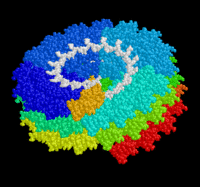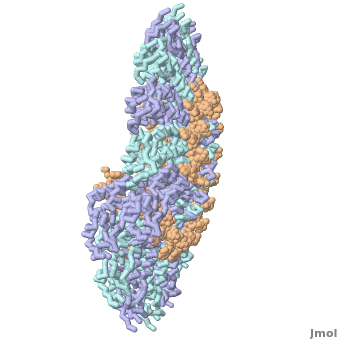Tobacco Mosaic Virus
From Proteopedia
Visualization of protein-nucleic acid interactions in a virus. Refined structure of intact Tobacco Mosaic Virus at 2.9 Angstroms resolution by X-ray fiber diffraction (2tmv)Tobacco Mosaic VirusTobacco Mosaic Virus (TMV) or satellite TMV is a positive-sense single stranded RNA virus that infects plants, especially tobacco and other members of the family Solanaceae. The infection causes characteristic patterns, such as "mosaic"-like mottling and discoloration on the leaves (hence the name). TMV was the first virus to ever be discovered. It is composed of 2130 identical coat protein subunits following the right-handed helix of an accompanying RNA strand to produce a 300 nm hollow cylinder with an outer diameter of 18 nm and a 4 nm wide central channel. This here is a protein-nucleic acid interactions in the virus. Caspar CarboxylatesTwo clusters of acidic amino acids are thought to be important for the disassembly of the helical structure of TMV. When the virus enters cells, the higher pH and lower calcium levels increase the repulsion of neighboring carboxylates, destabilizing the capsid. This concept was originally proposed by Caspar and subsequently examined by site-directed mutagenesis [1]. Several carboxylates were identified including Glu50 and ASP77, which contact each other in the helical stack (look closely at the two subunits that overlap in this lockwasher complex), and a cluster of four acidic amino acids, GLU95, GLU97, GLU106 and GLU109, near the center of the ring. This section complements the article on Tobacco Mosaic Virus in the Molecule of the Month Series. See also Teaching Scenes, Tutorials, and Educators' Pages.
Publication Abstract from PubMed
The structure of tobacco mosaic virus (TMV) has been determined by fiber diffraction methods at 2.9 A resolution, and refined by restrained least-squares to an R-factor of 0.096. Protein-nucleic acid interactions are clearly visible. The final model contains all of the non-hydrogen atoms of the RNA and the protein, 71 water molecules, and two calcium-binding sites. Viral disassembly is driven by electrostatic repulsions between the charges in two carboxyl-carboxylate pairs and a phosphate-carboxylate pair. The phosphate-carboxylate pair and at least one of the carboxyl-carboxylate pairs appear to be calcium-binding sites. Nucleotide specificity, enabling TMV to recognize its own RNA by a repeating pattern of guanine residues, is provided by two guanine-specific hydrogen bonds in one of the three base-binding sites. Visualization of protein-nucleic acid interactions in a virus. Refined structure of intact tobacco mosaic virus at 2.9 A resolution by X-ray fiber diffraction., Namba K, Pattanayek R, Stubbs G, J Mol Biol. 1989 Jul 20;208(2):307-25. PMID:2769760 From MEDLINE®/PubMed®, a database of the U.S. National Library of Medicine. About this Structure2TMV is a 2 chains structure with sequences from Tobacco mosaic virus. The January 2009 RCSB PDB Molecule of the Month feature on Tobacco Mosaic Virus by David Goodsell is 10.2210/rcsb_pdb/mom_2009_1. Full crystallographic information is available from OCA. |
| ||||||||||
3D structures of tobacco mosaic virus
Updated on 25-April-2022
1ei7, 3kml, 6i5a, 4bcu, 7m2v, 7m3r, 7m3t, 7m50, 7m54 - TMV coat protein
6r7m – TMV coat protein - CryoEM
6x0q, 6x0r - TMV coat protein (mutant)
1a34, 4oq8, 4oq9, 4nia, 7m2t, 7m57 - TMV coat protein + RNA
2om3, 2xea, 4udv, 3j06 , 6sae, 6sag, 5a79, 5a7a, 7og6 – TMV coat protein + RNA - CryoEM
2tmv, 1vtm – TMV coat protein + RNA - fiber
References
Primary Reference
Visualization of protein-nucleic acid interactions in a virus. Refined structure of intact tobacco mosaic virus at 2.9 A resolution by X-ray fiber diffraction., Namba K, Pattanayek R, Stubbs G, J Mol Biol. 1989 Jul 20;208(2):307-25. PMID:2769760
Additional References
- ↑ Caspar carboxylates: the structural basis of tobamovirus assembly. Wang H, Planchart A, Stubbs G. Biophys. J. 1998, 74, 633-638.
Created with the participation of Jaime Prilusky, Eran Hodis, David S. Goodsell.
Proteopedia Page Contributors and Editors (what is this?)
Michal Harel, Alexander Berchansky, Jaime Prilusky, Joel L. Sussman


